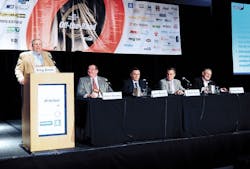The Tire Industry Association (TIA) Off-the-Road Tire Conference has long served as a valuable venue for learning not only about what’s happening in the OTR marketplace, but also about the overall economic health of many different industries.
This year’s 60th rendition of the conference did not disappoint. Both manufacturer keynote speaker Tim Easter, director of OTR sales for Yokohama Tire Corp., and Kevin Rohlwing, senior vice president of training for TIA, delivered similar appraisals of the market to the more than 500 attendees.
Easter said coal mining in the U.S. is declining as natural gas and oil increase in output. Also, the solar industry has twice as many jobs as coal mining. “Coal is here to stay, but it would be foolish not to believe alternative energies aren’t going to grow.”
He cautioned if fracking for oil and natural gas hits legal roadblocks, such as legislation in New York has already introduced, then coal could rebound. “In either case, there will be earthmoving equipment needed.”
In 2010, coal accounted for 45% of energy needs, natural gas 24%, nuclear 20%, renewables 10%, and oil and other liquids 1%, according to Easter. By 2035, the landscape is expected to be 39% coal, 27% natural gas, 18% nuclear and 16% renewables. Oil and other liquids will remain at 1%.
Easter pointed to forecasts by both Goldman-Sachs and Kiplinger that call for a growth in GDP of 3.1% or 3.3%, respectively for 2015. Both companies said the GDP grew 2.2% in 2014. This growth is leading to increased projections for the construction industry. Eighty percent of construction companies were planning to increase employment this year, according to Easter. “The wild card will be in retail space and what role Internet shopping will have on that.”
Rohlwing cited information from the 2015 Dodge Construction Outlook that forecasts a 15% increase in single-family housing; 9% increase in multi-family housing and 15% increase in commercial building for 2015. Equipment rental, which has a direct impact on OTR tire sales, is expected to grow at a 2.3% annual rate from 2015 through 2020, according to IBISWorld research Rohlwing presented. The 2014 equipment rental market was broken down by segments: 41.3% construction, 23.4% air transport, 16% industrial, 11.4% rail transport, 6.9% “other” and 1% water transport.
Rohlwing also used IBISWorld research to show a strong outlook for aggregate mining for the next several years, with 2015 output increasing between 6.5% and 7%. Going out until 2020, the aggregate mining forecast is projected to be 4.3% annualized. Aggregate mining segments are: 66.4% crushed limestone/dolomite, 13.5% crushed granite, 9.6% crushed stone, 6.7% crushed top rock and 2.8% other.
The outlook for metal and energy mining was not as positive. Rohlwing said Caterpillar expected oil, copper, coal and iron ore to reduce sales by 9% in 2015. Meanwhile, copper prices are expected to fall by 5%, nickel prices should rise by 8%, and zinc prices may increase by 3% this year. Goldman Sachs is forecasting a fall in gold prices from around $1,240 an ounce to about $1,050 by December.
What all this means for the OTR tire industry is that it is looking at slow growth for the next few years. Rohlwing said it is currently a $3 billion industry in the U.S., citing IBISWorld statistics
The $3 billion U.S. OTR tire market breaks down as follows:
- 69%, or $2.07 billion, for small OTR (rim diameters of 24 to 25 inches primarily used in construction);
- 15%, or $450 million, for large OTR (rim diameters of 29 to 49 inches primarily used in aggregate and small mines);
- 10%, or $300 million, for giant OTR (rim diameters of 51 to 63 inches primarily used in large mining operations);
- 5%, or $180 million, for repair materials (products used for the repair of OTR tires).
Overall, projected revenue is expected to steadily increase through 2020 to around $3.7 billion. On an annualized basis, IBISWorld is expecting a 4.5% annualized growth, but it should be noted that this includes a very large increase projected for 2019.
OTR tire revenues are broken down as follows: 43.1% construction, 24.2% mining, 22.8% exports, 6% agricultural and 3.9% other, according to Rohlwing.
Next year’s OTR Tire Conference will be held at the Omni La Costa Resort and Spa in Carlsbad, Calif., from Feb. 17-20. ■
About the Author
Greg Smith
Publisher
A 46-year tire industry veteran, Greg Smith is the publisher of Modern Tire Dealer. He also is the publisher of National Oil and Lube News.

